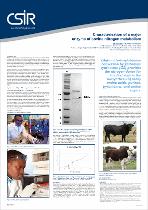JavaScript is disabled for your browser. Some features of this site may not work without it.
- ResearchSpace
- →
- Research Publications/Outputs
- →
- Conference Publications
- →
- View Item
| dc.contributor.author |
Mathomu, LM

|
|
| dc.contributor.author |
Myer, MS

|
|
| dc.contributor.author |
Kenyon, CP

|
|
| dc.date.accessioned | 2010-09-02T08:45:11Z | |
| dc.date.available | 2010-09-02T08:45:11Z | |
| dc.date.issued | 2010-09-01 | |
| dc.identifier.citation | Mathomu, LM, Myer, MS and Kenyon, CP. 2010. Characterisation of a major enzyme of bovine nitrogen metabolism. CSIR 3rd Biennial Conference 2010. Science Real and Relevant. CSIR International Convention Centre, Pretoria, South Africa, 30 August – 01 September 2010, pp | en |
| dc.identifier.uri | http://hdl.handle.net/10204/4289 | |
| dc.description | CSIR 3rd Biennial Conference 2010. Science Real and Relevant. CSIR International Convention Centre, Pretoria, South Africa, 30 August – 01 September 2010 | en |
| dc.description.abstract | Efforts are underway to produce transgenic pigs as source of organ transplants, transgenic fish for food, and transgenic livestock that are resistant to many animal diseases and can survive harsh environmental conditions. Nguni breed of cattle can survive under conditions that other bulk grazers, such as the European cattle breeds, find extremely testing. It is with this background, that our attention was drawn to the physiological and biochemical pathways of nitrogen metabolism in bovines (Bester, et al., 2003). Glutamine is one of the most abundant free amino acids, making about 20% of the total amino acid content in the body of most mammalian species, with the bulk being present in skeletal muscle, where it plays a role in the maintenance of cellular protein metabolism (Curthoys & Watford, 1995; Meister, 1974). Glutamine functions as a major inter-organ transport form of nitrogen, carbon and serves as a source of energy between tissues such as brain, liver, kidney and even muscles, in the mammalian body. Glutamine catabolism in the liver provides substrates for gluconeogenesis and urea synthesis. Although the exact pathway of precursor formation is not fully understood, the only known reaction yielding glutamine is that catalysed by glutamine synthetase, which converts glutamate and ammonia to glutamine, with the hydrolysis of ATP (Bester, et al., 2003). | en |
| dc.language.iso | en | en |
| dc.publisher | CSIR | en |
| dc.subject | Enzymes | en |
| dc.subject | Bovine nitrogen | en |
| dc.subject | Bovine nitrogen metabolism | en |
| dc.title | Characterisation of a major enzyme of bovine nitrogen metabolism | en |
| dc.type | Conference Presentation | en |
| dc.identifier.apacitation | Mathomu, L., Myer, M., & Kenyon, C. (2010). Characterisation of a major enzyme of bovine nitrogen metabolism. CSIR. http://hdl.handle.net/10204/4289 | en_ZA |
| dc.identifier.chicagocitation | Mathomu, LM, MS Myer, and CP Kenyon. "Characterisation of a major enzyme of bovine nitrogen metabolism." (2010): http://hdl.handle.net/10204/4289 | en_ZA |
| dc.identifier.vancouvercitation | Mathomu L, Myer M, Kenyon C, Characterisation of a major enzyme of bovine nitrogen metabolism; CSIR; 2010. http://hdl.handle.net/10204/4289 . | en_ZA |
| dc.identifier.ris | TY - Conference Presentation AU - Mathomu, LM AU - Myer, MS AU - Kenyon, CP AB - Efforts are underway to produce transgenic pigs as source of organ transplants, transgenic fish for food, and transgenic livestock that are resistant to many animal diseases and can survive harsh environmental conditions. Nguni breed of cattle can survive under conditions that other bulk grazers, such as the European cattle breeds, find extremely testing. It is with this background, that our attention was drawn to the physiological and biochemical pathways of nitrogen metabolism in bovines (Bester, et al., 2003). Glutamine is one of the most abundant free amino acids, making about 20% of the total amino acid content in the body of most mammalian species, with the bulk being present in skeletal muscle, where it plays a role in the maintenance of cellular protein metabolism (Curthoys & Watford, 1995; Meister, 1974). Glutamine functions as a major inter-organ transport form of nitrogen, carbon and serves as a source of energy between tissues such as brain, liver, kidney and even muscles, in the mammalian body. Glutamine catabolism in the liver provides substrates for gluconeogenesis and urea synthesis. Although the exact pathway of precursor formation is not fully understood, the only known reaction yielding glutamine is that catalysed by glutamine synthetase, which converts glutamate and ammonia to glutamine, with the hydrolysis of ATP (Bester, et al., 2003). DA - 2010-09-01 DB - ResearchSpace DP - CSIR KW - Enzymes KW - Bovine nitrogen KW - Bovine nitrogen metabolism LK - https://researchspace.csir.co.za PY - 2010 T1 - Characterisation of a major enzyme of bovine nitrogen metabolism TI - Characterisation of a major enzyme of bovine nitrogen metabolism UR - http://hdl.handle.net/10204/4289 ER - | en_ZA |






